Last Updated on 22.08.2024 by hrushetskyy
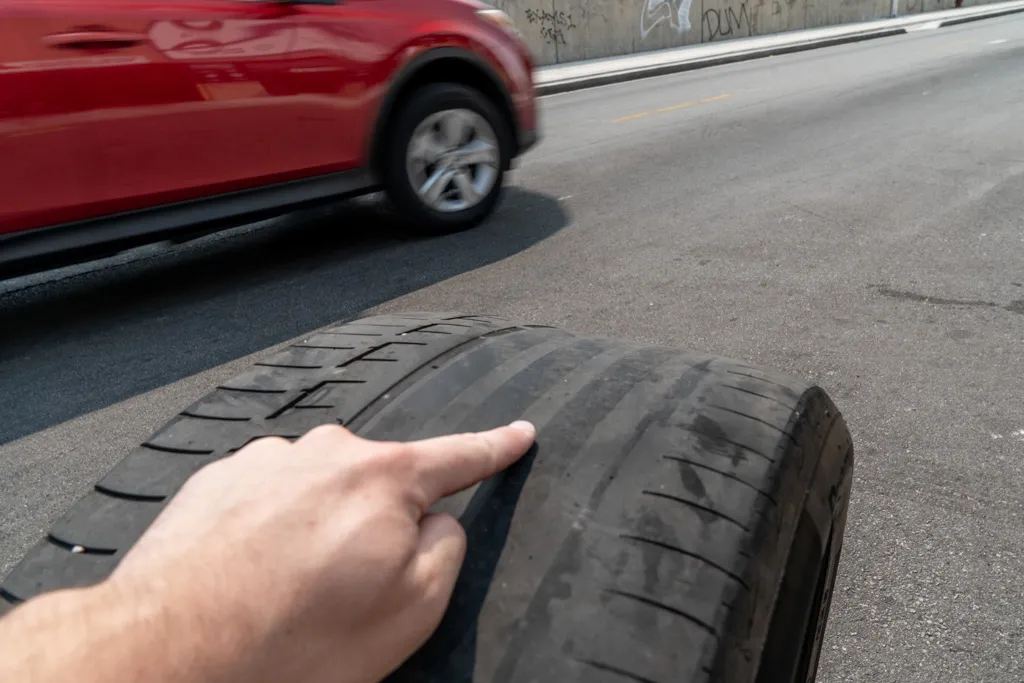
Uneven wear on tires can be a sign of problems with your car. Read on to learn about the reasons for uneven tire wear and how to prevent it.
Tread Carefully: Expert Tips for Avoiding Uneven Tire Wear
A good set of tires is expensive, so we want them to last as long as possible. But what happens when you spot signs of uneven tire wear? This might mean that you need a new set of tires or can even indicate issues with your car. In this article, we look at the main causes of uneven tire wear and what you can do to prevent it from happening.
Reasons for uneven tire wear
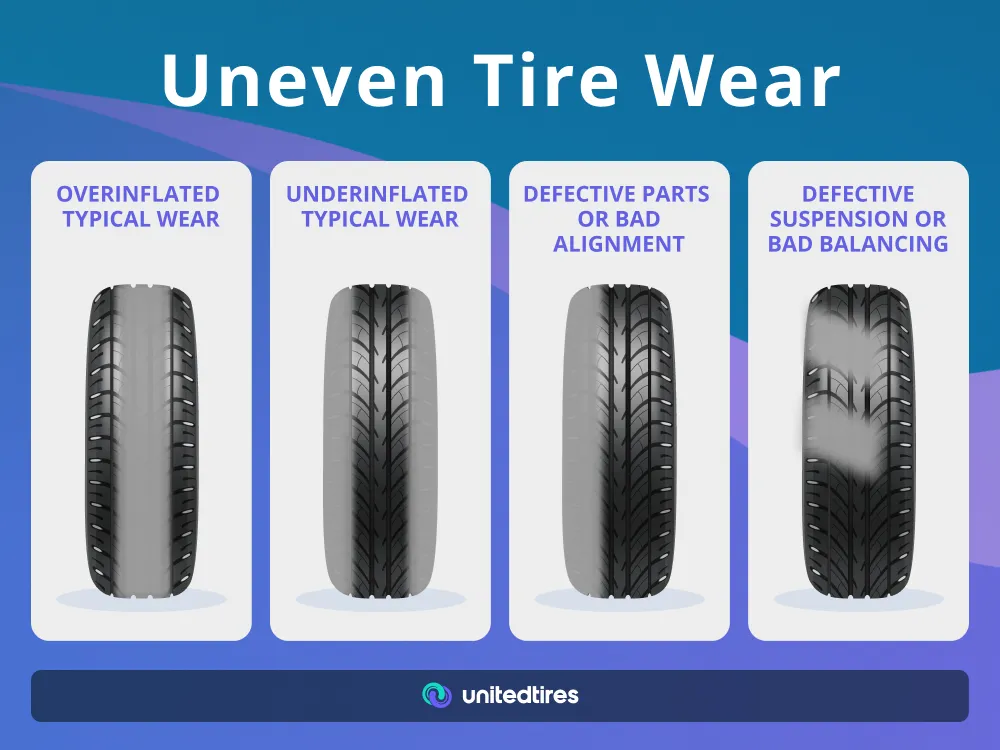
Did you know that you can usually tell the cause of irregular tire tread wear by where the tire wear patterns appear? Let’s look quickly at the common tire wear patterns and their causes before we move on to their solutions.
Shoulder or outer tire wear
When the outside edges or shoulders of your tires wear faster than the center of the tread, it is usually for one simple reason—incorrect tire pressure or underinflated tires. In the worst-case scenario, this can even lead to a blowout. This is why it is so important to check your tire pressure regularly and make sure it is at the manufacturer’s specifications.
One-sided wear
When you see one side of the tread wearing unusually fast, generally the inside edge, the causes are commonly mechanical. So, to answer the question ‘What causes tires to wear on the inside?’ the answer is:
- Improper wheel alignment (especially a faulty camber)
- Tires that have not been regularly rotated
- Carrying too heavy loads
- Regularly driving on roads with high crowns (a road that is higher in the center than the edge).
Feather edge wear
This type of uneven tire wear appears as wear in the tread blocks or ribs that have a feather-like appearance. The main causes of these tire wear patterns are:
- Improper wheel alignment (especially faulty toe-in)
- A bent axle beam.
The cost of uneven tire wear
Uneven tire wear can affect your car’s handling, especially in wet or wintery conditions. In extreme cases, it can even lead to a tire blowout. Additionally, if one area of your tire is wearing much faster than others, it may go below the legal minimum tread depth of 2/32”, meaning the tire needs to be replaced.
If you don’t replace the tire, your risk of a flat tire or blowout will increase. New tires are not cheap, and having to replace your tires due to uneven wear could set you back anywhere from $400 to over $1,200, depending on the type of tires and type of vehicle.
Solutions to tire tread wear problems
If you want to avoid these costly problems and make sure your tire tread wears evenly, here are some ways to fix common tread wear issues.
Check your tire pressure
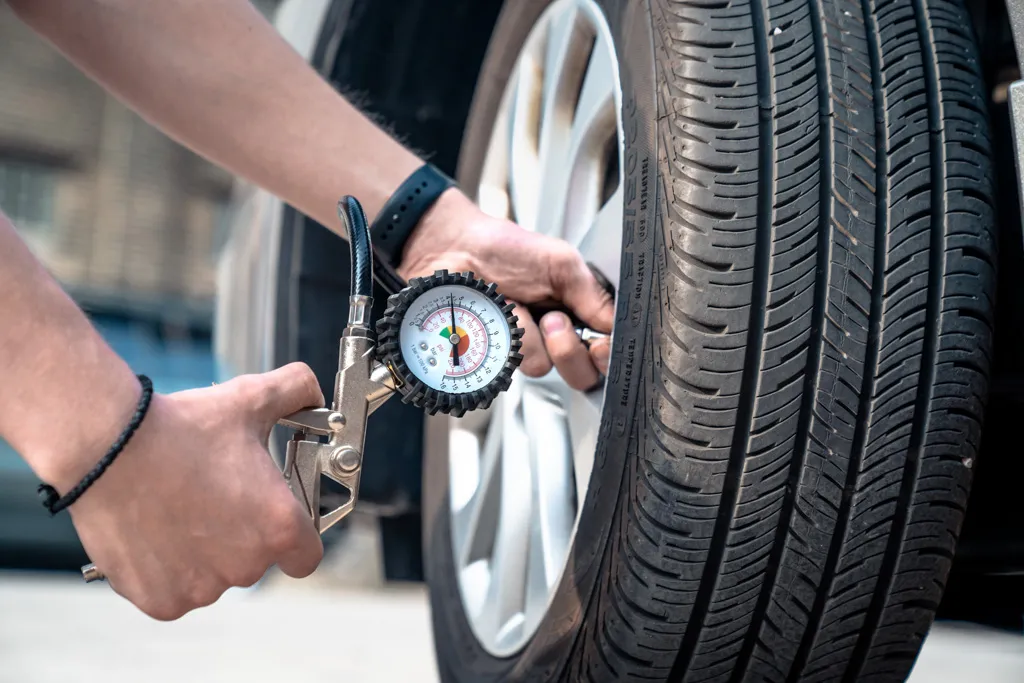
Underinflated tires can cause tire wear, particularly on the outer sides. Depending on which tires are underinflated, this can affect both the front and rear tires. Dealing with this issue is easy.
First, make sure you know your tire pressure. This will be shown in your vehicle’s user manual or on a plaque in the doorframe. The recommended pressure will also depend on the weight of the load you are carrying.
Remember to check your tire pressure regularly—we suggest at least once a month. If you notice any of your tires are losing more air than the others, check them for problems and fix them as soon as possible.
Check your wheel alignment
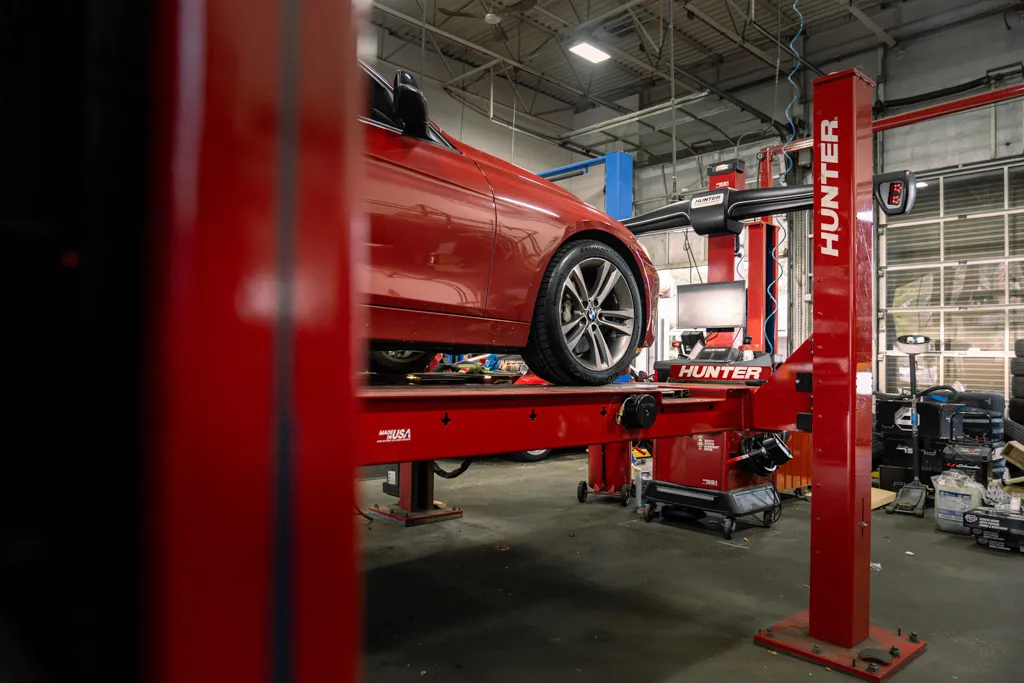
Wheel misalignment can lead to many issues with tread wear and your car’s overall performance. It can make your car handle badly, cause your tires to wear out more quickly, and lead to one-sided or feather wear patterns.
Issues with the suspension or steering system cause incorrect alignment. This can happen after hitting a pothole or getting into an accident. But when your wheels are properly aligned, they are in the correct position relative to your vehicle, so the vehicle’s weight is distributed across all your tires.
We recommend checking your alignment after fender benders, hitting large potholes hard, installing new tires or suspension parts, and rotating tires. As part of your regular car maintenance, your alignment should also be checked every 6,000-12,000 miles. As your wheels and suspension age, these inspections must be done more frequently.
Additionally, if you notice one-sided or feather wear patterns, you should take your car to a qualified mechanic to align your tires as soon as possible. However, it’s a good idea to check a couple of things:
- Tire pressure and inflation: If your tire pressure is too high or low, accurate alignment is impossible, so check your properly inflated tires first.
- Ride height: Accurate alignment will be impossible if your car’s suspension system has been lowered or lifted. Alignment relies on the relationship between various parts of your suspension system, so if your ride height differs from the factory specifications, it will be very hard to align your wheels correctly.
Wheel alignment in more detail
Various elements of wheel alignment can affect your tire wear. As you can see, wheel alignment is a complex topic and should always be carried out by a qualified professional.
Wheelbase
The wheelbase is the distance between the front and rear axles measured from the center of the hub. If this distance is not equal on both sides of the car, it can indicate that your suspension components are worn, bent, or damaged.
Tracking
Tracking is the distance of each wheel from the vehicle’s center line. To ensure the wheels are parallel to each other, they need to be the same distance from the center line. This enables the car to move in a straight line.
Camber
When you look at the wheels from the front of your car, you want them to be vertical. Camber is the tilt of any tire from vertical. A negative camber is when the top of the tire tilts toward the car, and a positive camber is when the top tilts away from the car. Camber is measured in degrees and varies by car model and year.
Camber angles should be adjusted so the tire has maximum contact with the road under particular driving and load conditions. For example, if you do a lot of hard cornering with a heavy load, you might need a slightly negative camber. However, camber can be zero or slightly positive for highway driving habits without any sharp cornering.
If your camber is set correctly for your driving habits, your vehicle will handle better, and your tires will wear more evenly. But if your camber is set incorrectly, certain areas of your tires can wear out more quickly.
Toe
To understand toe, imagine you are looking at your front tires from above. While you might expect them to be perfectly parallel, they rarely are. Toe is the difference, from parallel, in the distance between the front edge of the tires and the rear edge. Toed-in is when they are closer to the front of the tire, and toed-out is closer to the rear of the tire.
When set incorrectly, toe-in can cause understeer, while toe-out will cause oversteer. Both forms of the toe will cause feathered tire wear and excessive fuel consumption. A correctly set toe will help your tires wear evenly in various driving conditions, help you steer more smoothly, and save you money on gas.
NOTE: Wheel alignment should not be confused with tire balancing. Balance issues cause cupping, not uneven tire wear.
Cost of wheel alignment
Wheel alignment costs $65-$200, depending on the complexity of the alignment, the state, the vehicle, and the tire shop. Some dealerships also offer an unlimited warranty for about $170.
Mechanical parts
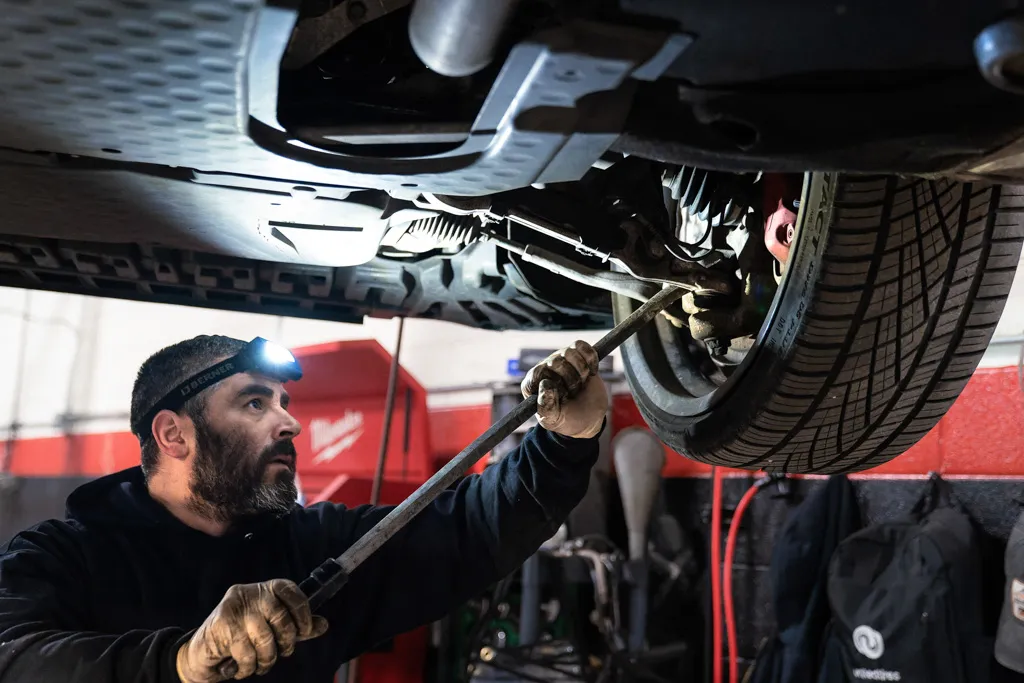
Some other mechanical parts may be causing your alignment wear-on tire problems. These include:
- Worn ball joints
- Sagging springs
- A bent strut or spindle
- Out-of-position strut tower
- Worn out control arm bushings.
Worn ball joints
If you see signs of tire wear on the outside edge of your front tires and slight feathering closer to the center, they could be a sign of a wearing out and/or failing ball joint. As the ball joint ages and wears, it makes the wheels point slightly outward, so the toe setting of the wheel alignment is out. Camber wear may also be connected to the ball joint-related issue.
Cost of ball joint replacement
Replacing four ball joints and aligning the wheels costs about $600-$700. If you also need to replace the control arm, the cost may increase to about $1,400-$1,500. Replacing one ball joint will cost between $250 and $400, depending on the type of vehicle. You can also replace the ball joints yourself.
NOTE: The lower ball joints may wear out sooner as they carry the entire weight of your vehicle.
Sagging springs
A constant load weakens the springs, making them lose arch (leaf spring) or/and height (coil spring). Tire wear on the outside edge can result from aging coil springs. As they lose height, so does the vehicle, causing the whole suspension to misalign, especially in the camber. If the leaf springs are also sagging or wearing out, they cause caster misalignment, which may worsen the situation.
Cost of spring replacement
A single spring replacement will cost from $215 to $439. The part is likely between $114 and $205, while the labor costs should be $101 to $234. The price may vary depending on the location and vehicle. You can also replace coil springs yourself.
Bent struts or spindles
The struts determine the camber position of the suspension, and if they’re bent, the alignment also changes. This means they can cause either inner or outer tire wear. If your strut is not badly bent or damaged, some tire shops may offer to straighten it rather than replace it. However, the best fix is to replace it.
As for the spindles, excessive pressure on the wheel hub can cause vibration, which may bend a spindle. As it bends, it may change the alignment of the wheel, leading to uneven tire wear patterns.
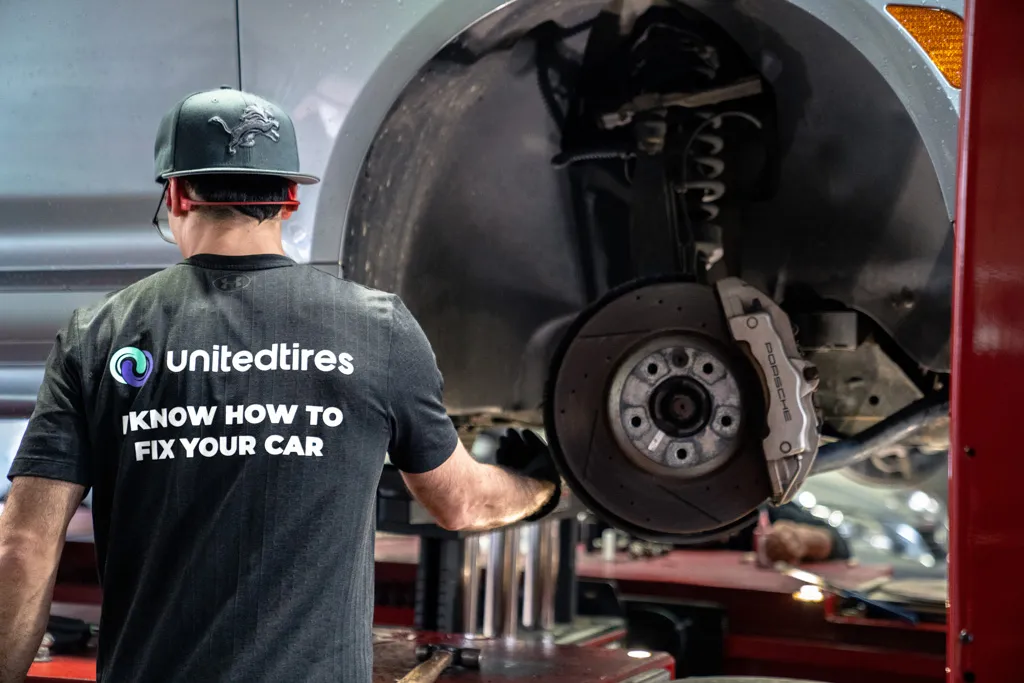
Cost of a bent strut or spindle repair
Replacing a bent strut may cost $488-$597, depending on the place and model of your vehicle. The price includes labor (about $290-$367) and the part cost (approximately $198-$230). Some places have higher prices of about $700. You may pay $1,000- $1,500 if you have a luxury car. You can also replace the struts yourself and save about $300.
Repairing a spindle may cost about $200, while installing a new one may cost about $300. This includes the part price of about $140 plus labor costs. Additional damage may add significantly to the price. For example, if the shaft is also damaged, you may need to pay as much as $4,000 to repair it.
Out-of-position strut tower
The strut tower can move out of position due to age as the metal rusts and weakens. When it does, the wheel’s camber setting becomes misaligned, causing tire wear on the outside edge. Strut towers help stabilize your vehicle, especially at high speeds, so you may also have difficulty controlling the car. If the tower fails, you may lose control of the vehicle completely.
Cost of strut tower repair
Strut tower repair may cost about $300, including the part price and labor. If you need to replace the whole tower, the price may rise rapidly to about $3,000. You can do it yourself, buying all the needed materials beforehand. You can also do it with a repair kit, which costs about $50, and a special adhesive, which costs about $55.
Worn control arm bushings
Bushings act like cartilage between suspension parts, and when they wear out, the control arm moves out of its proper position, causing wheel misalignment. Again, you may notice tire wear on the outside edge.
The bushings may wear prematurely due to harsh road conditions, salt, stress, and heat. If you notice cracking or wear, consider replacing the whole part.
Cost of control arm bushings repair
The cost may vary between $211 and $669, including labor costs of about $96 to $256 and a part price of $115 to $413. You can also install the new bushings yourself and save money on labor.
How to check tires for wear?
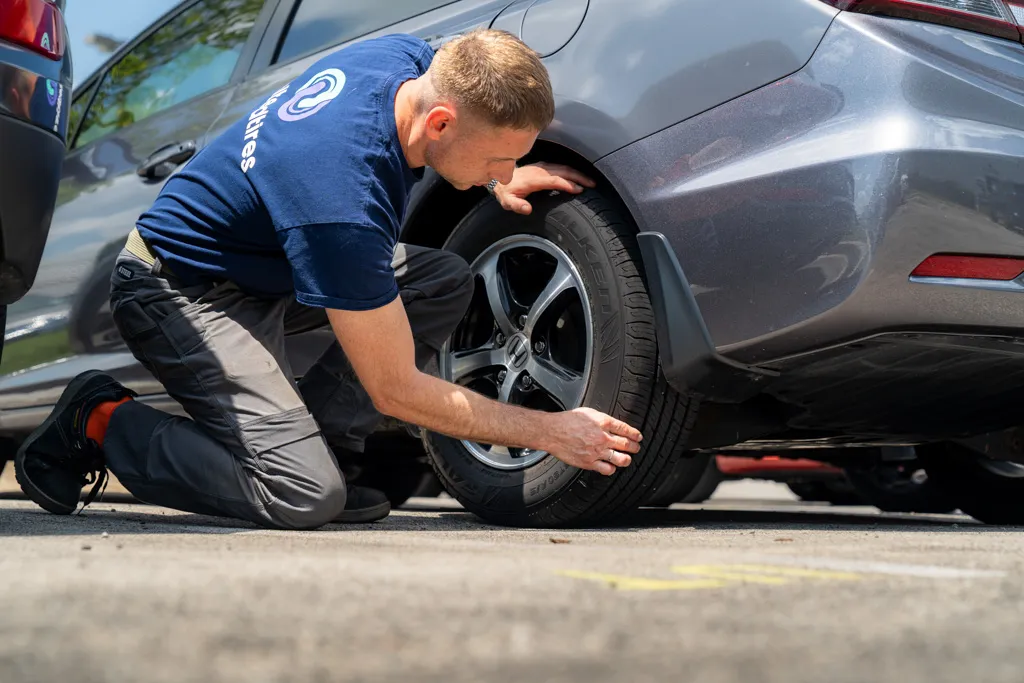
Checking your tires for uneven wear is simple but crucial to keep your car running well. Luckily, you can check for signs of uneven wear easily:
- First, find a flat and even surface on which to park your car, where you can easily see all four tires.
- Starting with one tire, inspect the tread across its width and around its circumference, looking for areas that seem more worn down than others.
- If you are unsure of how uneven the wear is, use a tread depth gauge for precision or even a quarter if you don’t have a gauge to hand.
- Compare each tire’s inner and outer sides and look for discrepancies in the amount of tread wear and signs of feathering.
- It’s also a good idea to look out for any visible cracks, bulges, or other signs of damage.
- Repeat this process for all four tires.
Uneven wear can indicate alignment issues, improper inflation, or suspension problems, so catching these signs early can help you prevent uneven tire wear, save money on future repairs, and ensure your car handles safely.
Frequently Asked Questions
Why is my tire wearing unevenly?
Uneven tire wear can be a sign of incorrect tire pressure, problems with alignment, or suspension issues. If your tires are under or over-inflated, they won’t make proper contact with the road, leading to wear on the edges or the center. A misaligned vehicle causes your tires to meet the road at an awkward angle, leading to uneven wear patterns and accelerated tire wear. Lastly, worn-out shocks or struts can throw off your car’s balance, affecting how your tires wear.
Should you replace tires with uneven wear?
If you notice the first signs of uneven wear on your tires, you may not need to replace them yet. However, if the uneven wear has led to tread areas with a depth of 2/32” or less, you should definitely replace your tires. If you do see irregular tire wear, be sure to get your tires checked by a professional, as it can be a sign of other issues with your vehicle’s alignment or suspension.
What is it called when tires wear unevenly?
When tires wear unevenly, it’s typically called “irregular tire wear” or “uneven tire wear.” This phenomenon can appear in various patterns, such as wear on one edge of the tire, center wear, feathering, or patchy wear across the tire’s surface. Each pattern indicates what the issue might be, for example, misaligned wheels, worn suspension components, or improperly inflated tires. This is why it’s so important to check your tires regularly and deal with any signs of irregular wear quickly.
Is it okay to drive on uneven tires?
If your uneven tire wear is minimal, it is probably okay to drive on them, but the more uneven the wear patterns are, the more risky it becomes. Uneven tires can cause a handful of issues, from unpredictable handling and increased wear and tear on your car’s components to reducing your vehicle’s overall safety. So, it’s best to address uneven tire wear as soon as you spot it. Keeping your tires in good shape not only ensures a smoother ride but also keeps you and your loved ones safe.
Share the Knowledge
